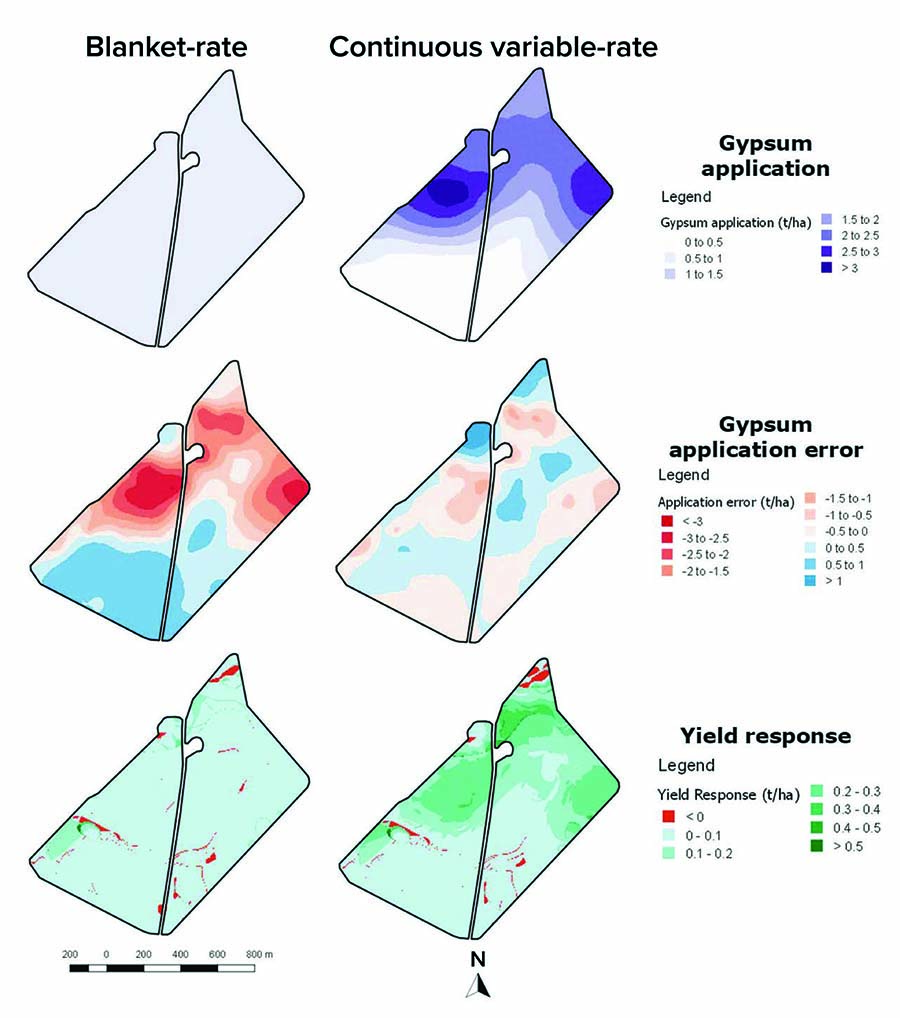Soil data is fundamental to economically accurate amelioration decisions.
Key points
- Consider soil data as a capital investment for your business, not an operational expense
- Increasing soil sampling is valuable to inform the soil amelioration approach in order to make economically accurate decisions
- This study was a pilot focusing on a northern region case study paddock
With Australian land prices at an all-time high, many grain growers are now investigating the status of their soil resource and considering investing in longer-term improvements.
In this respect, soil constraints should not be viewed negatively within the farming system, but instead as opportunities for improved production.
However, due to the highly variable nature of soil constraints at the sub-paddock scale, traditional approaches such as blanket-rate application often fail to target the highly constrained areas and over-apply ameliorants in areas where they are not required. Consequently, small application errors can be costly.

Figure 1: Simulated example of a spatial gypsum application for zero to 20-centimetre topsoil treatment of sodicity based on a sampling density of 20 cores, taking both a blanket-rate approach (left) and a pedometric, continuous variable-rate approach (right). For each simulated application, the gypsum application error and associated yield response is also displayed. The continuous variable-rate approach achieves a much more accurate application, which equates to more yield.
Photo: University of Southern Queensland
A variable-rate approach is most often required - but how many soil samples are necessary to make an economically accurate recommendation? Increasing soil sampling density will make for a more accurate recommendation; however, at some point the cost of soil analysis will exceed that of any economic benefit from soil improvements.
The minimum sampling requirement for agronomic recommendations is site-specific and dependent on the accuracy of spatial predictions, cost of sample collection and analysis, cost of soil amendment and application, depth of treatment and yield response due to amelioration.
To answer this question, a recent GRDC-invested PhD study, supervised by Professor John Bennett at the University of Southern Queensland, focused on understanding the economically optimum sampling density for soil amelioration.
A case study paddock located east of Warren, NSW, which had variable constrained soils and four years of yield data as a record of yield performance, was used.
Approach
Traditionally, mapping soil constraints at the sub-paddock scale has relied upon cheaply acquired surface-sensed information such as satellite imagery, EM38, elevation and yield data. While these are useful in identifying variability within a paddock, they cannot accurately diagnose soil constraints, particularly below the surface, without directly measured soil data.
The project used a statistical mapping approach known as 'pedometrics' to develop a digital map of soil constraints. This method uses laboratory-analysed soil data of certain soil types and other proximal data (for example, EMI, elevation, yield) to create continuous variable-rate application maps.
These maps are not reduced to zones, but instead offer the increased accuracy of true precision management, where every 12-by-12-metre pixel can be managed independently within the paddock.
Baseline data
The research aimed to identify the optimal sampling density for growers to make informed decisions about soil amelioration given the underlying field variability. This was achieved by collecting soil cores on a 60-by-60m grid (three cores per hectare) and analysed for moisture content, bulk density, texture, pH, electrical conductivity, aggregate stability and exchangeable cations (calcium, magnesium, sodium and potassium).
For a single core location, with four analysis depths (that is, zero to 10 centimetres, 10 to 20cm, 20 to 40cm and 40 to 60cm), this equated to 52 directly measured soil properties and an additional nine environmental covariates.
Using this benchmark dataset, the paddock's 'true' amelioration requirements were identified to a treatment depth of 60cm.
Outside of land and machinery, investing in soil health can be a major spend in any grain growing business. This grower story proves why it's worth investing || #GroundCover#agchatozhttps://t.co/2aRJLzBSQp
— GRDC (@theGRDC) November 18, 2019
Economic optimum sampling
The economically optimum sampling density was subsequently assessed by simulating gypsum recommendations at sampling densities of 0.1 to three samples/ha and comparing them to the original 'true' gypsum requirement maps.
This indicated how wrong the gypsum recommendation was (in terms of over and under-application) at varied sampling densities using either a blanket-rate, zone-based variable-rate or continuous variable-rate approach (Figure 1).
The cost of this error was then compared against the cost of sampling at each density to identify the economically optimum number. For the paddock investigated within the study, the economically optimal sampling density was approximately 0.2 cores/ha for topsoil treatment and 0.5 cores/ha for treatment to 60cm.
Site-specific
The minimum sampling requirement for agronomic recommendations is site-specific and is governed by the accuracy of spatial predictions, cost of sample collection and analysis, cost of soil amendment and application, depth of treatment and resultant yield response.
While the latter factors may be estimated and accounted for irrespective of site conditions, accuracy of spatial predictions is directly influenced by the variability of the site.
Soil constraints should not be viewed negatively within the farming system, but instead as opportunities for improved production.
Work continues in a new GRDC investment, developing a metric that will describe this variability to better inform sampling requirements for an individual site.
This metric will likely combine spatial data with yield data, satellite data, proximally sensed information and traditional field pedology (soil assessment) in a hybrid approach to recommend economically optimised sampling schemes.
More information: Stirling Roberton, stirling.roberton@usq.edu.au, 0417 138 503; John Bennett, john.bennett@usq.edu.au, 0438 683 426.

























































